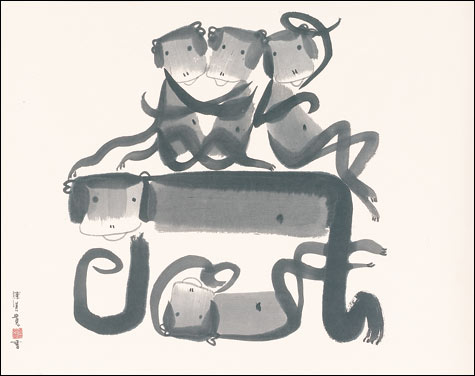Félix González-Torres at The Carpenter Center, Modern and Contemporary Chinese Ink Painting at the Sackler, and Chuck Close and Robert Storr at BU
By RANDI HOPKINS | October 23, 2007

Chen Qikuan, Monkeys |
| “Félix González-Torres” at Carpenter Center, 24 Quincy St, Cambridge | November 8–January 4 | 617.495.3251 | “A Tradition Redefined: Modern and Contemporary Chinese Ink Paintings from the Chu-Tsing Li Collection, 1950-2000” at Arthur M. Sackler Museum, 32 Quincy St, Cambridge | November 3–January 27 | 617.495.9400 | Chuck Close and Robert Storr Lecture at BU School of Management Auditorium, 595 Comm Ave, Boston | November 1 at 6 pm | 617.353.3371 |
Glittering piles of cheap candies — wrapped in shiny gold or brightly colored metallic papers, overflowing from the corner of gallery or museum spaces — are probably Cuban-born artist Félix González-Torres’s most iconic works. Minimal yet gaudy, formal yet messy, abundant yet diminishing (visitors were invited to take the candy), these works from the early 1990s married conceptual rigor, deep personal sentiment, and political activism, often taking the elegiac form of homage to mortality in the face of AIDS — a backdrop to González-Torres’s art activity during the late 1980s and early 1990s. González-Torres, who himself died from complications of AIDS in 1996, was chosen as the US representative to the Venice Biennale this past summer. His influential work is the subject of “FÉLIX GONZÁLEZ-TORRES” (opening at Harvard’s Carpenter Center on November 8), wherein he evokes complex responses via infinitely replaceable everyday materials. (In addition to candy, he used light bulbs, beads, and sheets of newsprint.) Art historian Miwon Kwon gives the lecture “Manifestations: Some Thoughts on the Work of Félix González-Torres” at the Carpenter Center on November 8 at 6 pm; that’s followed by an opening reception.Chinese ink painting underwent a dramatic evolution in the second half of the 20th century, reflecting China’s interest in Western modernism and its relationship to the values of traditional painting and also to those of the Communist regime following the establishment of the People’s Republic of China in 1949. “A TRADITION REDEFINED: MODERN AND CONTEMPORARY CHINESE INK PAINTINGS FROM THE CHU-TSING LI COLLECTION, 1950–2000” (opening at Harvard’s Sackler Museum on November 3) explores parallel lines of development in different geographical areas in China, Hong Kong, Taiwan, and abroad over this 50-year period, with work drawn from the collection of art historian Chu-tsing Li. In connection with this exhibition, the Sackler will host the M. Victor Leventritt Symposium on “Chinese Painting: The Twentieth Century and Beyond,” with lectures on November 2 and 3. The event is free; visit www.artmuseums.harvard.edu for details.
And on November 1 at 6 pm, BU’s School of Management Auditorium is the site of a talk by the dynamic duo of CHUCK CLOSE, who’s famous for his VERY BIG, highly pixilated paintings of faces, and ROBERT STORR, who curated the 2007 Venice Biennale and organized many big MoMA shows while he was Curator of Painting and Sculpture there between 1990 and 2002, including the retrospective “Chuck Close” in 1998.
On the Web
“Félix González-Torres” at Carpenter Center: www.ves.fas.harvard.edu
Arthur M. Sackler Museum: www.artmuseums.harvard.edu
BU School of Management Auditorium: www.bu.edu/cfa
 Related
Related:
Apocalypse now, Summer daze, Liquid masterpieces, More 
- Apocalypse now
Empyrean is one of the rare Internet-inspired pieces with rich, complex, coherent form.
- Summer daze
One of the invigorating qualities of summer art shows in Boston is their relative playfulness. Slideshow: Images from the galleries
- Liquid masterpieces
In honor of the exhibition, a number of bars and restaurants around Boston are offering drinks inspired by the art, the artists, and la Ville Lumière. Sqaures in Paris: What American painters didn't learn on their summer vacation. By Greg Cook.
- Touch the sky
The term “polyptych” usually refers to the multi-panel paintings designed as altarpieces for churches and cathedrals in Gothic and Renaissance Europe.
- A case of identity
In 2002, the year after his mother died, as Alex Matter tells it, he found a brown paper package in his father’s storage locker on Long Island.
- Natural selections
The gorilla is a black blur, out of nowhere, barreling into the cage door — clang! — and then zooming off through the fake rocks and trees.
- Review: Picasso and Braque Go to the Movies
Picasso seems to have done so, though preferring Chaplin slapstick and cowboy silents to artsy fare, and biographers place him at several screenings of Lumière shorts.
- Beautiful garbage
"Trash" at AS220's Project Space (93 Mathewson Street, Providence, through January 29) focuses on our love-hate relationship with garbage
- On what ground?
The experience gap between Greg Parker and Noa Warren makes their joint show at the June Fitzpatrick Gallery at the Maine College of Art all the more exciting.
- Water portraits
Despite their small size, Jessica Gandolf’s paintings have always had a large-scale operatic background informing their imagery.
- Looking back
The advantage of being a teaching museum is on full display at the Rhode Island School of Design in the exhibition “Re-Viewing the Twentieth Century.”
- Less

 Topics
Topics:
Museum And Gallery
, Culture and Lifestyle, Health and Fitness, Harvard University, More  , Culture and Lifestyle, Health and Fitness, Harvard University, Medicine, Sexual and Reproductive Health, Contagious and Infectious Diseases, HIV and AIDS, Sexually Transmitted Diseases, History, Painting, Less
, Culture and Lifestyle, Health and Fitness, Harvard University, Medicine, Sexual and Reproductive Health, Contagious and Infectious Diseases, HIV and AIDS, Sexually Transmitted Diseases, History, Painting, Less 